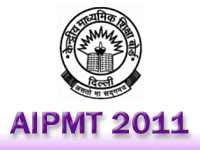All India PMT/PDT Entrance Examination 2011
AIPMT 2011: PHYSICS SYLLABUS
Unit : 1 Introduction and Measurement:
What is Physics? Scope and excitement; Physics in relation
to science, society and technology; Need for measurement of physical
quantities, units for measurement, systems of units-SI : fundamental and derived
units. Dimensions of physical quantities. Dimensional analysis and its
applications. Orders of magnitude, Accuracy and errors in measurement – random
and instrumental errors, Significant figures and rounding off the numbers.
Graphs, Trigonometric functions, Concepts of differentiation and integration.
Unit : 2 Description of Motion in One Dimension
Objects in motion in one dimension, Motion in straight
line, Uniform and non-uniform motion, its graphical representation and formulae,
speed and velocity, relative velocity, average speed and instantaneous velocity.
Uniformly accelerated motion, velocity-time graph, position-time graph and their
formulae. Relations for uniformly accelerated motion with examples. Acceleration
in one-dimensional motion.
Unit : 3 Description of Motion in Two and Three Dimensions
Vectors and scalars quantities, vectors in two and three
dimensions, vector addition and multiplication by a real number, null-vector
and its properties. Resolution of a vector in a plane, rectangular components.
Scalar and vector products. Motion in two dimensions, cases of uniform velocity
and uniform acceleration-projectile motion, general relation among
position-velocity-acceleration for motion in a plane and uniform circular
motion. Motion of objects in three dimensional space (elementary ideas).
Unit : 4 Laws of Motion
Force and inertia, first law of motion. Momentum, second
law of motion, impulse, examples of different kinds of forces in nature. Third
law of motion, conservation of momentum, rocket propulsion. Equilibrium of
concurrent forces. Static and kinetic frictions, laws of friction, rolling
friction, lubrication, Inertial and non-inertial frames (elementary ideas).
Unit : 5 Work, Energy and Power
Work done by a constant force and by a variable force, unit
of work, energy and power. Work Energy Theorem. Elastic and in-elastic
collisions in one and two dimensions. Notions of potential energy, conservation
of mechanical energy : gravitational potential energy, and its conversion to
kinetic energy, potential energy of a spring. Conservative forces. Different
forms of energy, mass-energy equivalence, conservation of energy.
Unit : 6 Rotational Motion
 Get Your Dream Job. SUBMIT YOUR RESUME Online.
Get Your Dream Job. SUBMIT YOUR RESUME Online.| CLASS-X | Class XII | AIEEE | AIPMT | ICSE | Results | Tips | Videos | Answer Keys | IIT-JEE | Subjects | JOBS | HOTS | Download |
 Email Newsletter
Email Newsletter  FREE SMS ALERTS |
FREE SMS ALERTS |  Join at FACEBOOK ,
Join at FACEBOOK ,  TWITTER.
TWITTER.